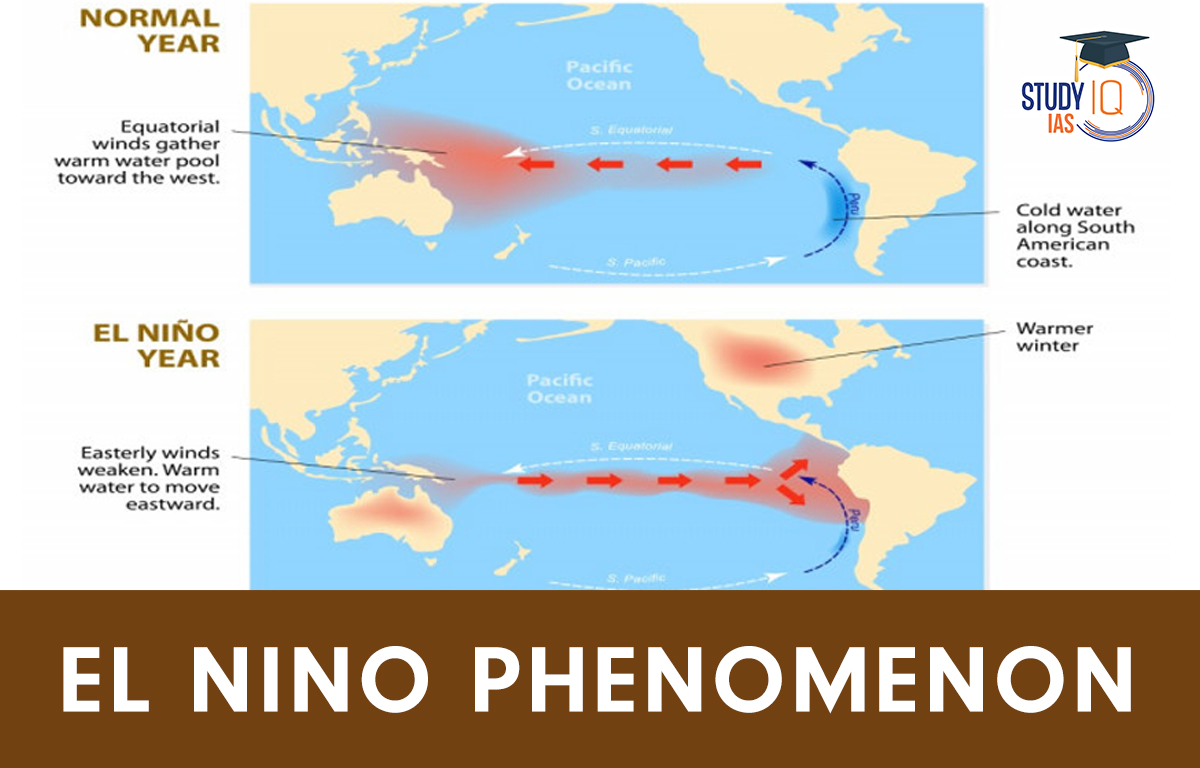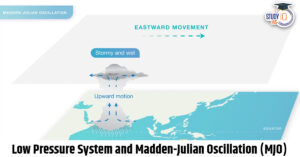Table of Contents
Context: The 2023-2024 El Niño has become one of the top five strongest recorded, impacting global climate even as it begins to weaken.
More in News
- Global Sea-Surface Temperatures: Despite El Niño’s influence, the WMO has observed exceptionally high sea-surface temperatures globally over the past ten months, with January 2024 being the warmest January on record.
- Climate Impact: The impacts of El Niño are most pronounced in the second year of occurrence, indicating that 2024 will experience significant climate effects.
- Projected Temperature Rise: The WMO expects that the ongoing El Niño effect will lead to above-normal land temperatures across most regions in the coming three months.
- Strength of the Current El Niño: The current El Niño, which began in June 2023, reached its maximum intensity between November and January, with temperatures around 2 degrees Celsius higher than the 1991-2020 average in the eastern and central tropical Pacific, ranking it among the strongest occurrences.
- Socioeconomic Consequences: El Niño has profound repercussions on communities and economies, but timely seasonal forecasts by the WMO have enabled countries to prepare and mitigate potential impacts on agriculture, water resources, and health sectors.
| World Meteorological Organisation (WMO) |
Mission
History
Structure
Major Programs
Membership: Currently consists of 187 member countries. Headquarters: Geneva, Switzerland. |
About El-Nino
- El Nino is a Spanish word that means ‘The Little Boy’.
- The occasional climatic change and development of warm ocean surface waters along the coast of Peru and Ecuador are called El Nino effect.
- Mechanism: In El Nino, the trade winds which blow along the Equator from east to west weakened and created high air pressure in the Western Pacific Ocean and low air pressure in the eastern Pacific Ocean.
- Due to this, the surface water moves towards the coast of northern South America.
- The central and east Pacific Ocean warms up for six months, creating an El Nino effect.
- During El Nino, warming the central and east Pacific oceans reduces the usual upwelling of cold water, ultimately reducing the nutrient content in that region.
- An El Niño this year could increase the planet’s average surface temperature by more than 1.5° C from pre-industrial levels.
Effects of El-Nino on India
- Monsoon: El Nino and Indian monsoons are inversely related.
- Droughts: The most prominent droughts in India – six of them – since 1871 have been El Nino droughts, including the recent ones in 2002 and 2009
- However, not all El Nino years led to a drought in India. For instance, 1997/98 was a strong El Nino year but there was no drought (Because of IOD).
- On the other hand, a moderate El Nino in 2002 resulted in one of the worst droughts.
- Agrarian economy: El Nino directly impacts India’s agrarian economy as it tends to lower the production of summer crops such as rice, sugarcane, cotton, and oilseeds.
About La Nina
- It is an atmospheric wind and sea surface temperature (SST) variability phenomenon occurring over the equatorial Pacific.
- It refers to an abnormal cooling of the central and eastern Pacific Ocean waters off the coasts of Ecuador and Peru.
- Such cooling (SSTs falling 0.5 degrees Celsius or more below a 30-year average for at least five successive three-month periods) is a result of strong trade winds blowing west along the equator, taking warm water from South America towards Asia.
- The warming of the western equatorial Pacific, then, leads to increased evaporation and concentrated cloud-formation activity around that region, whose effects may percolate to India as well.
- It is characterized by a negative Oceanic Niño Index (ONI value) exceeding or equal to minus 0.5 degrees i.e ENSO (El Niño-Southern Oscillation) cycle has entered a “neutral” phase.
- La Nina is associated with good rainfall in India.
Comparison Between El Nino and La Nina
Here are the key differences described below for El Nino and La Nina:
| El Nino | La Nina |
| The trade winds, which blow from east to west, diminish during an El Niño. | The trade winds that blow from east to west intensify during La Nina. |
| Warm seas build up over the eastern Pacific Ocean during El Nino. | Warm water builds up across the western Pacific Ocean during La Nina. |
| Over the western Pacific, the El Nino is packed with high air surface pressure. | Low air surface pressure is present during La Nina across the eastern Pacific Ocean. |
| El Nino has low wind speeds. | The wind speed is particularly high during La Nina. |
| Coriolis force strength declines during El Nino. | However, during La Nina, the Coriolis force becomes stronger. |
| In the eastern Pacific Ocean and surrounding nations like Chile, Peru, and Ecuador, El Nino causes excessive rainfall. | La Nina causes drought-like conditions over the eastern Pacific Ocean, affecting neighboring nations like Chile, Peru, and Ecuador. |
El Niño Southern Oscillation (ENSO)
The combination of El Niño, La Niña, and the neutral state between the two opposite effects is called the El Niño Southern Oscillation (ENSO). The phenomenon was discovered by Sir Gilbert Walker.


 Places in News for UPSC 2025 for Prelims...
Places in News for UPSC 2025 for Prelims...
 Iron Ore, Types, Uses, Distribution in I...
Iron Ore, Types, Uses, Distribution in I...
 Low Pressure System and Madden-Julian Os...
Low Pressure System and Madden-Julian Os...





















